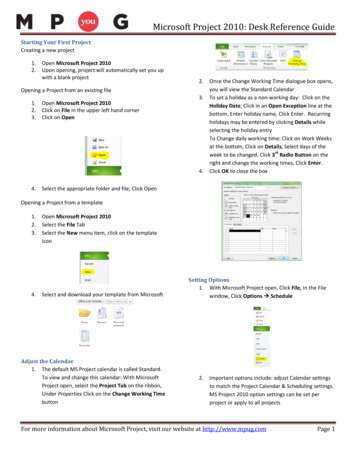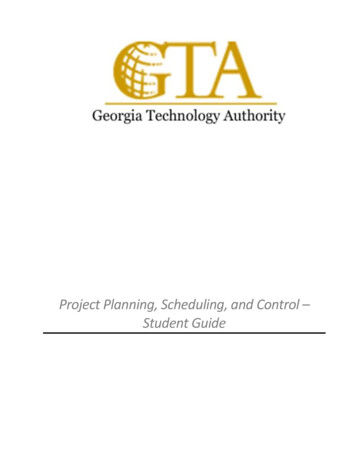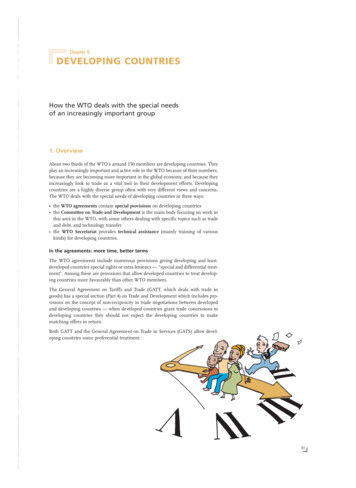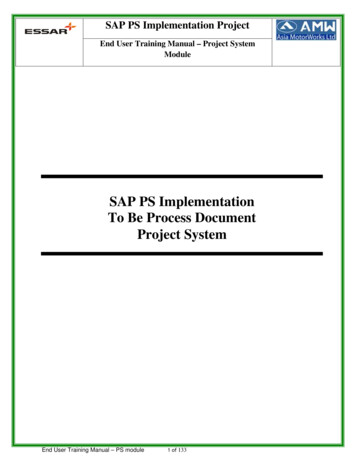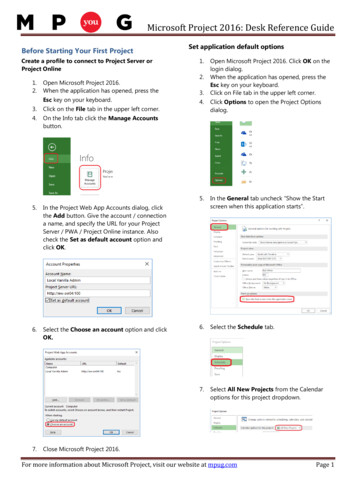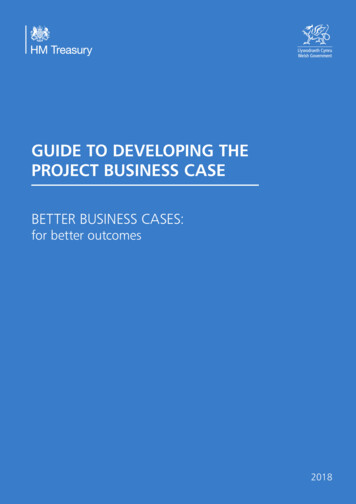
Transcription
GUIDE TO DEVELOPING THEPROJECT BUSINESS CASEBETTER BUSINESS CASES:for better outcomes2018
Crown copyright 2018This publication is licensed under the terms of the Open Government Licencev3.0 except where otherwise stated. To view this licence, visit e/version/3 or write to the Information PolicyTeam, The National Archives, Kew, London TW9 4DU, oremail: psi@nationalarchives.gsi.gov.uk.Where we have identified any third party copyright information you will need toobtain permission from the copyright holders concerned.This publication is available at www.gov.uk/government/publicationsAny enquiries regarding this publication should be sent to us atpublic.enquiries@hmtreasury.gsi.gov.ukISBN 978-1-5286-0460-4CCS0518648068-1PU2145
GUIDE TO DEVELOPING THEPROJECT BUSINESS CASEBETTER BUSINESS CASES:for better outcomes2018
ContentsForeword vEditors’ Note viiChapter 1. Introduction 1What is a project? 1How does a project align with the strategic planning process? 1What is the importance of the Project Business Case using the Five Case Model? 2What are the advantages of the Project Business Case? 3When should the Project Business Case be developed? 3What is Project Assurance? 4Chapter 2. An Overview of the Five Case Model 7Introduction 7The Strategic Case 7The Economic Case 8The Commercial Case 9The Financial Case 9The Management Case 10Chapter 3. The Business Case Development Process 11Introduction 11The Business Case Development Framework 11Determining the strategic context and undertaking the Strategic Assessment 12Stage 1 – Scoping the scheme and preparing the Strategic Outline Case (SOC) 13Stage 2 – Planning the scheme and preparing the Outline Business Case (OBC) 13Stage 3 – Procuring the solution and preparing the Full Business Case (FBC) 14Implementation and monitoring 15Evaluation and feedback 15Other interested parties 15Smaller Schemes and the Business Justification Case (BJC) 16Responsibility for producing the business case 16Business Case template 16Chapter 4. Determining the Strategic Context and undertaking the StrategicAssessment 17Introduction 17Step 1: Determining the Strategic Context 17Chapter 5. Scoping the proposal and preparing the Strategic Outline Case (SOC) 19Introduction 19Step 2: Making the case for change 19Action 2: Agree strategic context 19Organisation Overview 19Alignment to existing policies and strategies 20Action 3: Determine spending objectives, existing arrangements and businessneeds 20Guide to developing the Project Business Casei
ContentsDetermining spending objectives Determining existing arrangements Identifying business needs Action 4: Determine potential business scope and key service requirements Action 5: Determine benefits, risks, constraints and dependencies Identifying the main benefits Identify the main risks Identify the constraints Identifying the dependencies Workshop 1 – Case for Change Step 3: Exploring the preferred way forward Action 6: Agree critical success factors for the project Action 7: Determine the long-list options and undertake SWOT analysis Identifying options The Options Framework Using the Options Framework to identify the long-list Drafting the long-list Action 8: Recommend a preferred way forward Drafting the short-list Workshop 2 – Identifying and assessing the options Referencing the Commercial, Financial and Management Cases 212222222323242525262727282829303535363940Chapter 6. Planning the scheme and preparing the Outline Business Case (OBC) 43Introduction 43Step 4: Determining potential Value for Money (VfM) 43Action 9 – Revisit the SOC and determine the short-list 43Action 10 – Prepare the economic appraisals for shortlisted options 44Action 11 – Undertake benefits appraisal 51Action 12 – Undertake risk appraisal 52Action 13 – Select preferred option and undertake sensitivity analysis 57Workshop 3 – Assessing the Short-listed Options 60Step 5: Preparing for the potential Deal 61Action 14: Determine procurement strategy 61Action 15: Determine service streams and required outputs 62Action 16: Outline potential risk apportionment 63Action 17: Outline potential payment mechanisms 64Action 18: Ascertain contractual issues and accountancy treatment 66Workshop 4 – Developing the Deals 67Step 6: Ascertaining affordability and funding requirement 68Step 7: Planning for successful delivery 75Action 20: Plan project management – strategy, framework and plans 75Action 21: Plan change management – strategy, framework and outline plans 77Action 22: Plan benefits realisation – strategy, framework and outline plans 78Action 23: Plan risk management – strategy, framework and outline plans 79Action 24: Plan project assurance and Post-Project Evaluation – strategy,framework and plans 81Workshop 5 – Successful Delivery Arrangements 82Chapter 7. Procuring the proposal and preparing the Full Business Case (FBC) 85Introduction 85Step 8: Procuring the VfM solution 85Action 25: Revisit the case for change 85Action 26: Revisit the OBC options 86iiGuide to developing the Project Business Case
ContentsAction 27: Detail the procurement process and the evaluation of Best And FinalOffers (BAFOs) Step 9: Contracting for the Deal Action 28: Set out the negotiated Deal and contractual arrangements Action 29: set out the financial implications of the Deal Step 10: Ensuring successful delivery Action 30: Finalise project management arrangements and plans Action 31: Finalise change management arrangements and plans Action 32: Finalise benefits realisation arrangements and plans Action 33: Finalise risk management arrangements and plans Action 34: Finalise contract management arrangements and plans Action 35: Finalise Post-Project Evaluation arrangements and plans 8788888990909091919292Chapter 8. Reviewing the Business Case: SOC, OBC and FBC 95Introduction 95The Strategic Outline Case 95The Full Business Case 99Annex A: Case Study showing the relationship between strategy, programme andproject 103Annex B: Overview of how to develop the Project Business Case 105Annex C: Project scoping document 107Annex D: Overview of steps and actions for the preparation of Project BusinessCases 111Glossary 113The Author: 116The Editor: 116Bibliography 117Guide to developing the Project Business Caseiii
ForewordIncreasing demand for public services creates ever more pressure on the public resourcesavailable, increasing the need to make better use of these limited resources. The challenge tothose preparing and advising on spending decisions has never been greater. In this context, itis vital that spending and investment decisions are based on highly competent professionallydeveloped proposals. This best practice guidance from the Treasury and the Welsh governmenthas been refined and tested over many years, and it provides a clear framework for thinkingabout spending proposals and a structured process for appraising, developing and planning todeliver best social value for money: all of which is captured through a well prepared businesscase to support objective, evidence based decisions.This latest version of the best practice guidance is updated to maintain its alignment with therefreshed Green Book 2018. It provides a practical “step by step” guide to the development ofbusiness cases, using the Five Case Model – in a scalable and proportionate way. It recognisesand aligns with other best practice in procurement and the delivery of programmes andprojects. Experience has demonstrated that when this guidance is embedded in public sectororganisations, better more effective and efficient spending decisions and implementation plansare produced. At the same time the approach when correctly understood and applied providesa more efficient planning and approval process saving between 30% and 40% in time taken andcost of production of business cases compared with unstructured approaches.The guide provides a framework for thinking and a process for developing and gaining approvalwhich is flexible and scalable as well as a range of tools that can be applied proportionately toprovide clarity in the decision support process. It also provides a clear audit trail for purposes ofpublic accountability.All centrally funded public spending proposals including those subject only to approval by UKDepartments or other centrally funded organisations are required to use this approach and thefive case model method, as are major programmes and projects considered by the Treasury andCabinet Office. Colleagues with responsibility for developing proposals should be professionallytrained and accredited through the better business cases programme established in 2013.Since the beginning of 2014 training in a correct understanding and use of the methodhas been widely available. Links to access training can be found on the same GOV.UK webpage as this guide and on the Welsh government web pages. We are therefore very pleasedto recommend the use of this guidance and the approved training and accreditation to allwho are concerned with delivering best social value for money from decisions on the use ofpublic resources.Tom ScholarPermanent Secretary HM TreasuryShan MorganPermanent Secretary Welsh GovernmentGuide to developing the Project Business Casev
Editor’s NoteThis Green Book methodology brings together the Green Book approach to appraising publicvalue with the Cabinet Office, Infrastructure and Projects Authority (IPA) project assurance, andthe latest commercial standards and procurement methodologies from the Crown CommercialService (CCS). It also supports Treasury spending scrutiny and approval processes. It is bestpractice methodology and should be used by those responsible for using public resources indeveloping proposals to scope, analyse, plan, procure and manage delivery to achieve bestvalue.This refreshed edition of the guidance is an updated version of the 2013 edition reflecting theupdated Green Book published in March 2018 Programme and Project guidance is publishedin two separate guides to allow greater clarification of the how the model should be applied inpractice when thinking about these two different but related activities.For some years, in addition to the UK and Welsh governments the New Zealand Treasury andthe States of Guernsey have used the guidance tailored to meet the needs of their processesand governance. Since 2014 there has been a growth in international interest in both theguidance and the professional accreditation scheme and use of the scheme by governmentsaround the world, international NGOs’ and private companies has been growing. The fiveprinciples adopted by the G20 in 2018 for the preparation of infrastructure schemes nationallyand regionally are the central pillars of the five case mode. To support the international processof professional accreditation and examinations new international editions of the guidance havealso been produced and are available separately to these UK versions.Thanks are due to Joe Flanagan for origination of the five case model and authorship of theguidance, with whom I have been privileged to work on both this publication and the BetterBusiness Cases accreditation and training programme. This programme, jointly run by theTreasury and the Welsh Government, recognises that guidance is necessary but alone is notsufficient to ensure best use of resources. Training and professional accreditation is now widelyavailable, and more information is available at this link. Accreditation is now expected of to allwho work in developing practical best value proposals for delivery of public services using thefive case model.Others who have made contributions to the development of the guidance over the years andto whom thanks are also, due include: Simon Brindle; Paul Nicholls; Dr Courtney Smith; StefanSanchez; Phil Saw; The Health Finance Management Association (HFMA); Barry Williams andto many other colleagues in HM. Treasury and across the UK civil service whose experiencecontributed to development of this supplementary Green Book Guidance.Joseph LoweEditor of the Green BookHM Treasury 2018Guide to developing the Project Business Casevii
1IntroductionA project management approach is essential for the delivery of a set of related productsand activities, in order to ensure effective management, benefits realisation and Value forMoney (VfM).This guidance has been prepared to assist: Senior managers and executives responsible for designing, delivering and approvingprojects, including Senior Responsible Owners (SROs), project directors, project managersand business case practitioners and reviewers.It will also be of interest to: members of Senior Management Boards with responsibility for approving businesscases; and directors of Finance, Planning and Procurement and others with responsibility foroperational aspects of the project.What is a project?A project is a temporary organisation that is needed to produce a specific predefined outcomeor result at a pre-specified time using predetermined resources.The Managing Successful Projects with PRINCE2 guidance defines a project as ‘a managementenvironment that is created for the purpose of delivering one or more business productsaccording to a specified business case’.Most projects have the following characteristics: a defined and finite life cycle clear and measurable inputs and outputs a corresponding set of activities and plans a defined amount of resource, and an organisational structure for governance and delivery.How does a project align with the strategic planning process?A project can be a major undertaking for most organisations, involving significant funding andchange for the parties involved.Figure 1 shows a typical environment for project management.Guide to developing the Project Business Case1
Chapter 1: IntroductionInternal or External operating environmentPolitical, Economic, Sociological, TechnologicalInfluence and ShapePolicies, Strategies, Initiatives and TargetsDefine Scope and PrioritiseProgrammesInitiate, Align and MonitorProjects and related activitiesImplement and DeliverNew or Transformed Business Operations ServicesBring AboutOutcomes Achieved and Benefits RealisedOrganisations achieve their vision and mission through business strategies, policies,initiatives and targets that are influenced and shaped by the political, economic, sociological,technological and legal environment in which they operate.Organisations’ implementation strategies consist of strategic portfolios that scope, define andprioritise the programmes needed to deliver the agreed change, anticipated outcomes andresultant benefits.These programmes initiate, align and monitor the projects and related activities required todeliver the agreed outputs. These outputs may consist of new products and services, newprocesses and service capabilities, or changes to business operations. But it is not until theprojects deliver and implement the required outputs into business operations to achieve theoutcomes that the full benefits of the programme can be realised.A continual process of alignment is required to ensure that the programme and its projectsremain linked to strategic objectives, because even as projects are in the process ofimplementing changes and improvements to their target business operations, they may need torespond to changes in strategies or accommodate new initiatives or policies.A case hypothetical study showing the relationship between strategy, programmes and projectsis provided at Annex A.What is the importance of the Project Business Case using the FiveCase Model?The Project Business Case is important because projects will only deliver their intended outputsand benefits if they are properly scoped, planned and cost justified from the outset.Preparing a Project Business Case using the five case model provides decision makers andstakeholders with a proven framework for structured ‘thinking’ and assurance that the project:2Guide to developing the Project Business Case
Chapter 1: Introduction Provides strategic fit and is supported by a compelling case for change.This dimension of the five cases focuses on business planning and is the ‘strategic case’section within the Project Business Case. Will maximise public value to society through the selection of the optimalcombination of components, products and related activities.This dimension of the five cases focuses on options appraisal and the identification ofthe preferred option and is the ‘economic case’ section within the Project Business Case. Is commercially viable and attractive to the supply side.This dimension of the five cases focuses on the development and procurement of thepotential Deal and is the ‘commercial case’ section within the Project Business Case. Is affordable and is fundable over time.This dimension of the five cases focuses on the whole life costs of the proposed Deal andis the ‘financial case’ section within the Project Business Case. Can be delivered successfully by the organisation and its partners.This dimension of the five cases focuses on the implementation arrangements for theproposal and is the ‘management case’ section within the Project Business Case.What are the advantages of the Project Business Case?A well prepared Project Business Case: enables the organisation and its key stakeholders to understand, influence and shapethe project’s scope and direction early on in the planning process assists decision makers to understand the key issues, the available evidence base and toavoid committing resources to schemes that should not proceed demonstrates to senior management, stakeholders, customers and decision makers thecontinuing viability of the project, and provides the basis for management, monitoring and evaluation during and afterimplementation.When should the Project Business Case be developed?A Project Business Case is recommended best practice and should be prepared followingthe approval of senior management to the organisational strategy, mandate and brief forthe project.The organisational strategy provides the context for the project and is important becauseexperience shows that a proposal begins most effectively when it is launched as part of a clearorganisational strategy.The project mandate provides the trigger and context at the start of the project. The projectbrief develops the concept for the scheme and provides an initial assessment of the viability andachievability of the proposal, prior to formally developing the Project Business Case.Guide to developing the Project Business Case3
Chapter 1: IntroductionThe project mandate and brief should be prepared in accordance with a recommended projectmanagement methodology and are dependent upon the organisation’s top managementteam having defined and agreed the policies and business strategies for the organisation,including high level strategies for sourcing and service delivery and the prioritisation of new andexisting work.The Project Business Case is a working document which must be developed and revisited overthe duration of the scheme.Developing a Project Business Case applies to all types of projects and requires trained peoplewho have the capabilities and competencies to undertake the tasks involved.What is Project Assurance?Project assurance provides independent and impartial confirmation that the project or anyone of its activities is on track. It also confirms that the project is applying relevant practicesand procedures and that the business rationale for the scheme remains aligned with theorganisational strategy.Experience demonstrates that there is significantly added value in an organisation subjecting itsprojects to rigorous assurance, since the effort and resources saved by refocusing or cancelling aproject that is no longer needed far outweighs its continued cost.Projects may be subject to one or more of the following assurance reviews: The Project Validation Review Project Assessment Reviews (PARs) Cabinet Office Gateway ReviewsThe Project Validation ReviewThis is a short independent peer assessment that takes place at the early stages of the policy-todelivery lifecycle for projects.The review provides organisations early on in the planning process with assurance on howwell the practical service delivery issues are being addressed in preparing for change throughproject delivery.Project Assessment Reviews (PARs)These are complementary to Gateway reviews but more specific and in-depth in nature.Working in collaboration with the project team, PARs provide assurance that the project’sscoping and delivery options are being planned in line with national strategies and policies toachieve optimal public value at affordable cost.Cabinet Office Gateway ReviewsThe Cabinet Office Gateway Review process examines programmes and projects at key decisionpoints in their delivery lifecycle and provides assurance that they can progress successfully to thenext stage.These reviews apply to a wide range of programmes and projects, including: policy development and implementation4Guide to developing the Project Business Case
Chapter 1: Introduction organisational change and other change initiatives acquisition programmes and projects property/construction developments IT-enabled business change procurement using or establishing framework arrangements.The key review points are as follows: Gateway 0 – ‘Strategic Assessments’ on an ongoing assurance of programmes at thestart, delivery and closing stages.And for projects: Gateway 1 – ‘Business Justification’ prior the detailed planning phase. Gateway 2 – ‘Delivery Strategy’ prior to the procurement phase. Gateway 3 – ‘Investment Decision’ prior to contract signature. Gateway 4 – ‘Readiness for Service’ prior to ‘going live’ and implementation of thescheme. Gateway 5 – ‘Operational Review and Benefits Realisation’ following delivery of theproject, establishment and/or decommissioning of the service.Risk Profile AssessmentA risk profile assessment should be undertaken prior to developing the Project Business Case.This assesses the project’s potential impact against a continuum of very high, high, medium andlow risk that indicates how Gateway Reviews should be resourced and conducted.Guide to developing the Project Business Case5
2An Overview of the Five CaseModelIntroductionThis chapter provides an overview of the Five Case Model Methodology for the preparation ofbusiness cases.The Five Case Model is applicable to policies, strategies, programmes and projects and comprisesof five key dimensions: The Strategic Case The Economic Case The Commercial Case The Financial Case The Management CaseThe Strategic CaseThe purpose of the strategic dimension of the business case is to make the case for change andto demonstrate how it provides strategic fit.Demonstrating that the scheme provides synergy and holistic fit with other projects andprogrammes within the strategic portfolio requires an up-to-date organisational businessstrategy that references all relevant local, regional and national policies and targets.Making a robust case for change requires a clear understanding of the rationale, drivers andobjectives for the spending proposal, which must be made SMART – Specific, Measurable,Achievable, Relevant and Time constrained – for the purposes of post-evaluation.Key to making a compelling case for intervention is a clear understanding of the existingarrangements: the Business As Usual (BAU), business needs (related problems andopportunities), potential scope (the required organisational capabilities) and the potentialbenefits, risks, constraints and dependencies associated with the proposal.The challenges are: to explain how further intervention and spend on key ‘inputs’ will deliver ‘outputs’that improve the organisation’s capability to deliver better outcomes and benefits tostakeholders and customers, while recognising the associated risks to ensure the organisation’s proposals focus on business needs that have been wellresearched and are supported by service demand and capacity planning to ensure schemes are planned and delivered as part of an approved organisationalstrategy that has a well defined portfolio of related programmes and projects.Guide to developing the Project Business Case7
Chapter 2: An Overview of the Five Case ModelBox 1: Contents of the Strategic CaseStrategic ContextOrganisational overviewBusiness strategy and aimsOther relevant strategiesThe Case for ChangeSpending objectivesExisting arrangementsBusiness needs – current and futurePotential scope and service requirementsMain benefits and risksConstraints and dependenciesThe Economic CaseThe purpose of the economic dimension of the business case is to identify the proposal thatdelivers best public value to society, including wider social and environmental effects.Demonstrating public value requires a wide range of realistic options to be appraised (thelong-list), in terms of how well they meet the spending objectives and critical success factors forthe scheme; and then a reduced number of possible options (the short-list) to be examined infurther detail.The short-list must include the BAU, a realistic and achievable ‘do minimum’ that meetsessential requirements, the preferred way forward (if this is different) and any other optionsthat have been carried forward. These options are subjected to cost benefit analysis (CBA) orcost effectiveness analysis (CEA), where more appropriate, to identify the option that offers bestpublic value to society.The challenges are: to begin by selecting the ‘right’ options for scope, solution, service delivery, implementationand funding, otherwise options will represent sub-optimal Value for Money (VfM) fromthe outset to justify higher cost options in relation to BAU and the ‘do minimum’ to measure and monetise the benefits and risks.Box 2: Contents of the Economic CaseCritical Success factorsLong-listed optionsPreferred Way ForwardShortlisted options (including the “Business As Usual (BAU)” and ‘do minimum’)NPSC/NPSV findingsBenefits appraisalRisk assessmentSensitivity analysisPreferred option8Guide to developing the Project Business Case
Chapter 2: An Overview of the Five Case ModelThe Commercial CaseThe purpose of the commercial dimension of the business case is to demonstrate that thepreferred option will result in a viable procurement and a well-structured Deal between thepublic sector and its service providers.Demonstrating a viable procurement requires an understanding of the market place, knowledgeof what is realistically achievable by the supply side and research into the procurement routesthat will deliver best value to both parties.Putting in place a well-structured Deal requires a clear understanding of the services, outputsand milestones required to be achieved and of how the potential risks in the Design, Build,Funding and Operational (DBFO) phases of the scheme can best be allocated between the publicand private sectors and reflected in the charging mechanism and contractual arrangements.The challenge for the public sector is to be an ‘intelligent customer’ and to anticipate from theoutset how best public value can continue to be secured in during the contract phase in the faceof inevitable changes to business, organisational and operational requirements.Box 3: Contents of the Commercial CaseProcurement strategy and routeService requirements and outputsRisk allocationCharging mechanismKey contractual arrangementsPersonnel implicationsAccountancy treatmentThe Financial CaseThe purpose of the financial dimension of the business case is to demonstrate the affordabilityand funding of the preferred option, including the support of stakeholders and customers,as required.Demonstrating the affordability and fundability of the preferred option requires a completeunderstanding of the capital, revenue and whole life costs of the scheme and of how the Dealwill impact upon the balance sheet, income and expenditure and pricing arrangements (if any)of the organisation.The challenge is to identify and resolve any potential funding gaps during the lifespan ofthe scheme.Box 4: Contents of the Financial CaseCapital and revenue requirementsNet effect on prices (if any)Impact on balance sheetImpact on income and expenditure accountOverall affordability and fundingConfirmation of stakeholder/customer support (if applicable)Guide to developing the Project Business Case9
Chapter 2: An Overview of the Five Case ModelThe Management CaseThe purpose of the management dimension of the business case is to demonstrate that robustarrangements are in place for the delivery, monitoring and evaluation of the scheme, includingfeedback into the organisation’s strategic planning cycle.Demonstrating that the preferred option can be successfully delivered requires evidencing thatthe scheme is being managed in accordance with best practice, subjected to independentassurance and that the necessary arrangements are in place for change and contractmanagement, benefits realisation and risk management.The challenges are: to manage the risks in the design, build, funding and operational phases of the schemeand put in place contingency plans to deal with inevitable business and service change in a controlled environment, and to ensure that objectives are met, anticipated outcomes delivered and benefits evaluated.Box 5: Contents of the Management CaseProgramme management governance arrangements (roles, responsibilities, plans etc.)Project management governance arrangementsUse of specialist advisersChange and contract management arrangementsBenefits realisation arrangements (including plans and register)Risk management arrangements (including plans and register)Post-implementation and evaluation arrangementsContingency arrangements and plans10Guide to developing the Project Business Case
Chapter 8. Reviewing the Business Case: SOC, OBC and FBC 95 Introduction 95 The Strategic Outline Case 95 The Full Business Case 99 Annex A: Case Study showing the relationship between strategy, programme and project 103 Annex B: Overview of how to develop the Project Busines





